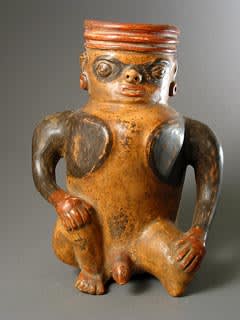Seated Male Effigy Vessel, 500 CE - 800 CE
Terracotta
13.5
PF.4100
Further images
Symbolic content is of major importance in pottery representations. Polychrome vessels from this period frequently portray humans with various attributes, often costumed as animals such as alligators and bats. In...
Symbolic content is of major importance in pottery representations. Polychrome vessels from this period frequently portray humans with various attributes, often costumed as animals such as alligators and bats. In this case however, the artist who created this remarkable vessel has shown a man with a very definite purpose. The figure is in a seated position resting on one knee, with the right foot extended. The hands are poised lightly on the knees as he leans slightly to his left; a pose which makes it seem he has just come to rest, briefly, as if tracking an animal. Black paint around the eyes in a mask shape contributes to this impression. He is in fact a shaman or sorcerer with the unusual deformity of a pigeon chest and hunchback. The Ancient Costa Ricans revered these features, especially when the individual was a sorcerer. It was believed such a person’s physical malformation was a sign he was singled out by the gods. The fact his penis is prominent suggests he may have been involved in fertility rites. Shamans were very knowledgeable about plant and animal life, and were probably consulted on problems such as impotency. Whatever his mission may be, this shaman is certain to be spellbinding wherever he next comes to rest.







